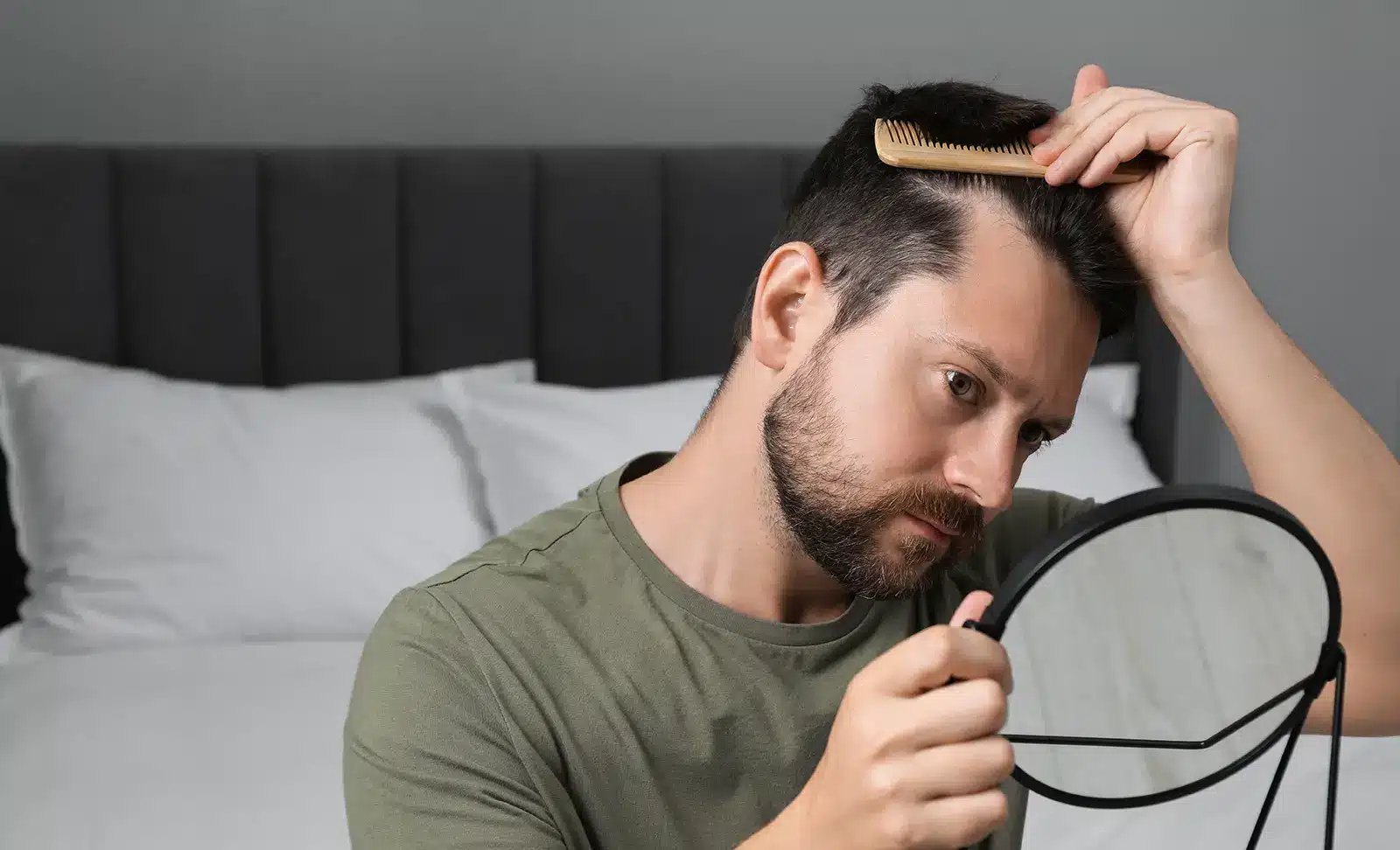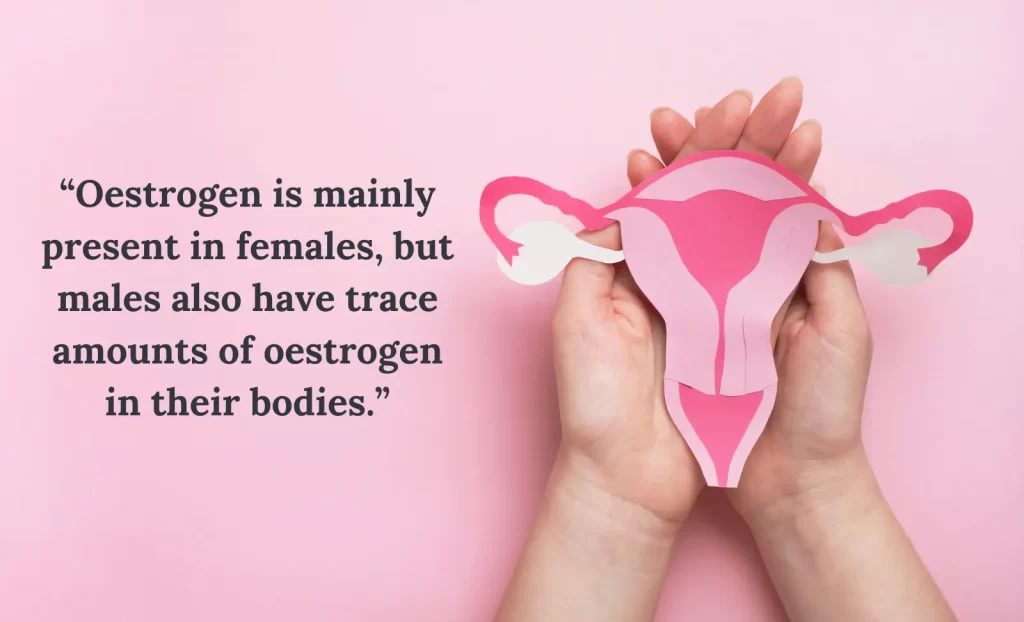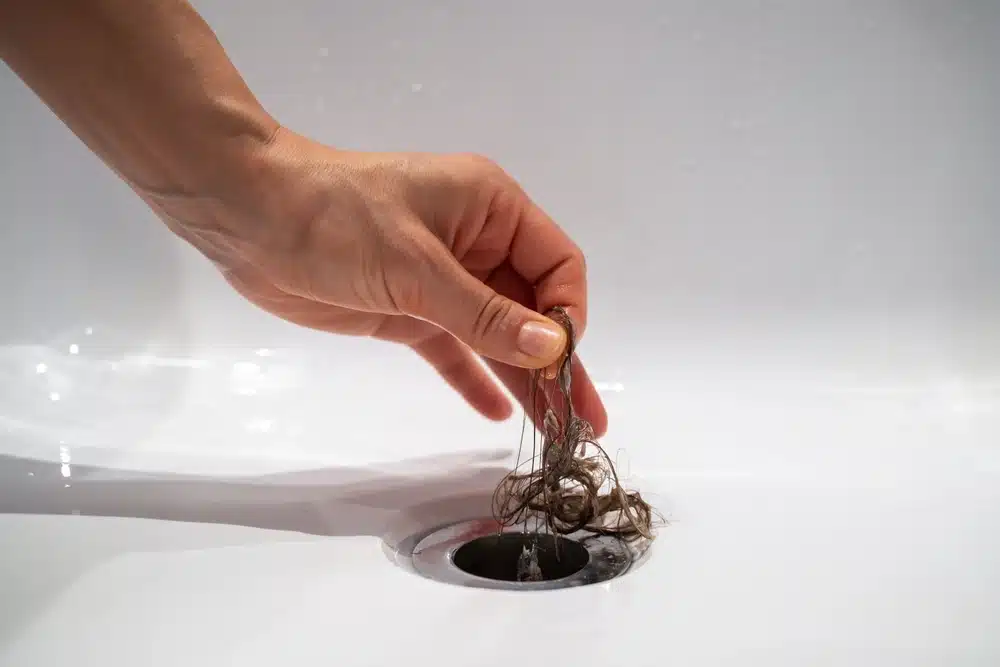Hormones are chemicals that carry messages around your body. The hormones in men and women are slightly different, with women typically carrying more oestrogen and men carrying more testosterone.
Testosterone indirectly causes hair loss. This is because testosterone gets converted into dihydrotestosterone (DHT), the hormone responsible for the shrinkage of hair follicles, which, in turn, causes hair loss. That’s why hair loss is so much more common in men, affecting 85% of men in their lifetimes compared to 50% of women.
Due to this, some people may think that taking oestrogen for male hair loss is key to regrowing hair. Is there any truth to this, however? In this guide, find out all you need to know about how effective oestrogen is for regrowing hair.
What is Male Pattern Baldness?
Male pattern baldness, also known as male androgenetic alopecia, is a common type of hair loss caused by genetics. It affects most men at some point in their lives, often causing them to lose hair from their temples (creating a receding hairline) and the crown of the head. While there is no cure, there are hair loss treatments that can slow down hair loss and stimulate new growth.
Understanding the Role of Oestrogen
Now, let’s understand exactly what oestrogen is and its role in the body.
As mentioned, oestrogen is mainly present in females, but males also have trace amounts of oestrogen in their bodies. The hormone is mainly responsible for the development of the female reproductive system. [1] There are certain points in a woman’s life in which her oestrogen levels drop significantly, and this includes after childbirth and during menopause.
What About Testosterone?
Testosterone works a little differently, with testosterone levels dropping slowly (around 1% a year) throughout a man’s life, causing no significant and immediate changes. What does change is DHT production, with men who are more sensitive to the hormone DHT experiencing hair loss, and this is completely genetic. So, someone bald does not necessarily produce particularly high levels of testosterone compared to another man with a full head of hair.
The Link Between Oestrogen and DHT
The main reason people theorise that oestrogen for male hair loss could help is because oestrogen may be able to stop the production of DHT, at least indirectly.
DHT is a sex hormone that comes from testosterone, which greatly impacts hair follicles. DHT shrinks the follicles and shortens the hair cycle [2], leading to hair loss. This usually affects men around the temples and at the crown of the head, and it often worsens with age.
Oestrogen is not able to directly prevent DHT production. However, it can inhibit androgens, the overall term for all the male hormones, which includes DHT.
Does Taking Oestrogen for Male Hair Loss Help?
It must be noted that, at this point, there is no direct evidence to suggest that oestrogen can reverse male hair loss. It’s just a theory due to oestrogen’s ability to inhibit androgens. Still, it’s an interesting idea and for those with androgenetic alopecia, worth thinking about.
There is the potential for oestrogen to have the opposite effect. If a person takes more oestrogen, it could even lead to hair loss, plus there are various other negative effects to be aware of.
The Side Effects of Taking Oestrogen as a Man
Men taking oestrogen can cause a hormonal imbalance, leading to a variety of unpleasant symptoms, including [3]
- Decreased Libido
- Breast Tissue Presence
- Softer, Oilier Skin
- More Fat Around the Chest and Hips
- Erectile Dysfunction
- Thinning Hair
Should You Take Oestrogen for Male Hair Loss?
No – it’s recommended that you do not take oestrogen to treat hair loss. As mentioned, there is no concrete evidence that taking this hormone can actually reverse hair loss, and it may have some more negative effects. Plus, there are other hair restoration options you can opt for, many of which have been clinically proven. We will go into those a little further down.
Can Oestrogen Help with Female Pattern Hair Loss?
Both men and women can experience genetic hair loss; in women, it is called female pattern hair loss. Oestrogen plays a very important role in a woman’s body, including in the hair growth cycle, as it helps keep the hair in the growing phase, leading to more hair growth.
Taking oestrogen can help some women reverse hair loss and encourage hair regrowth, especially during periods when oestrogen levels drop (such as during menopause). This is called HRT (hormone replacement therapy) and is quite common. HRT can help prolong the anagen (growth) phase while protecting the hair follicles, preventing them from shrinking. So, oestrogen is a more effective treatment for female pattern baldness than male pattern baldness.
Alternative Options for Treating Male Pattern Baldness
While there is a link between oestrogen and DHT, with oestrogen inhibiting androgens, that doesn’t mean taking oestrogen HRT is a good idea. Thankfully, there are alternative options for treating male pattern baldness, many of which have provided extremely successful results.
Minoxidil
Minoxidil is a topical hair loss medication used to treat androgenetic alopecia and is available to both men and women. You can purchase minoxidil over-the-counter (often under the brand name Rogaine), and it comes in two different strengths: 2% and 5%.
While it’s not 100% known exactly why minoxidil reverses hair loss caused by male pattern baldness, it is known that it increases blood vessel size and boosts blood flow to the scalp, meaning scalp hair has a better chance of growing.
Minoxidil is easy to get hold of, simple to use, and makes a difference. However, it can be expensive over time, and you must keep applying it daily for the results to stick – the hair follicles will shrink once you stop using it. Side effects are minimal, potentially causing burning and redness on the scalp.
Finasteride
Finasteride is another medication used to treat hair loss. This one is specifically for men and is commonly prescribed to treat enlarged prostates.
Finasteride is a 5-alpha reductase inhibitor [4] that blocks the production of DHT, as mentioned previously, the hormone responsible for genetic male hair loss. As such, it can help reverse hair loss, allowing men to regrow a full head of hair once more.
While finasteride is available on the NHS for treating prostate issues, it is not available on the NHS when used for regrowing hair – when needed for this purpose, patients will need to pay for it privately. Plus, there are side effects to be aware of, such as erectile dysfunction, lowered sexual desire, testicle pain, and mood problems.
Dutasteride
Dutasteride works similarly to finasteride in that it prevents the production of DHT. It is usually used for benign prostatic hyperplasia but can be sought out for male hair loss.
Dutasteride is very effective for treating male pattern baldness. However, like finasteride, it has side effects such as a lower sex drive and erectile dysfunction.
Hair Transplant
Arguably, a hair transplant is the most effective way of treating androgenetic alopecia. The FUE hair transplant is particularly popular due to its natural results with minimal scarring. The process involves harvesting hair follicles from the back or sides of the scalp, where the terminal hairs are strongest, and then transplanting them to the recipient area (where the patient has hair loss).
Once these follicles are placed into the recipient area, they take root and grow new hairs. It is a permanent solution to male pattern baldness, with results lasting a lifetime.
Should You Get a Hair Transplant?
Out of all the treatments for hair loss in men, a hair transplant is the most effective due to the permanent results – you don’t have to continue taking or applying a medication. So, should you get one? Here’s what to consider.
Cost: Hair transplants are more costly than other hair restoration treatments – they can range anywhere from £1,000 to £30,000 in the UK. However, many people find this cost worth it because of the permanent results.
Cause of Hair Loss: Is your hair loss caused by androgenetic alopecia? Hair transplants are best for treating genetic hair loss; other types of hair loss, such as telogen effluvium, require a different type of treatment.
The Clinic: Always choose a reputable clinic before opting for a hair transplant. The best surgeons provide genuinely natural results.
If you want to learn more about hair transplants and speak to expert surgeons, download our hair track app.
Oestrogen Hair Loss Male: Final Thoughts
While the theory of using oestrogen for male hair loss makes sense, taking oestrogen to reverse your hair loss is not a good idea – there isn’t enough research to back it up, and it could even end up contributing to hair loss.
If your male pattern baldness is getting you down, rest assured, there is hope to regrow your hair. If you want proof, just head to our patients gallery to see what our hair restoration surgery has done for past clients!
Sources:
- https://www.healthdirect.gov.au/oestrogen#:~:text=cause%20breast%20cancer?-,What%20is%20oestrogen?,maintaining%20healthy%20cholesterol%20levels
- https://www.healthline.com/health/dht
- https://www.healthline.com/health/effects-of-estrogen-on-male-body#gender-affirming-care
- https://medlineplus.gov/druginfo/meds/a698016.html#:~:text=Finasteride%20is%20in%20a%20class,scalp%20that%20stops%20hair%20growth.




